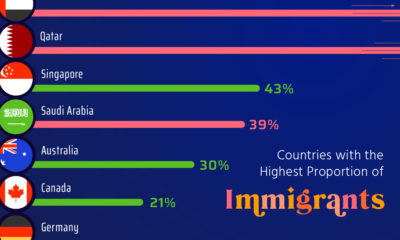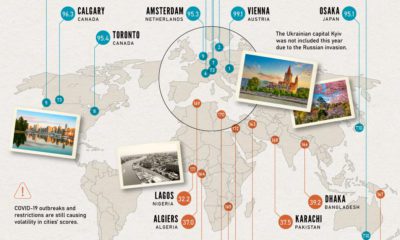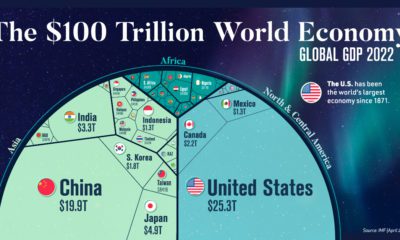Over 80% of the world’s economic output is derived from activities in cities – and more specifically, it’s estimated that 60% of GDP growth occurs in just the top 600 urban centers. Given the above, it’s fair to say that the destiny of humankind is directly linked to what happens in major cities. Further, how urbanization plays out over time could end up having a significant ripple effect on the economy, and we should pay close attention to such trends.
Urbanization 2.0
Today’s infographic comes to us from Raconteur, and it showcases eight different ways that urban demographics are evolving. Below we will summarize the changes, along with potential impacts on the economy:
- A Higher Percentage of Urban Dwellers Between 1950 and 2018, we went from 30% to 55% of the world’s population living in cities. This has been driven largely by today’s middle and high income economies in places like North America, South America, Europe, and Japan. The next stage of urbanization will see us move to 68% – more than two-thirds of the world’s population – living in these urban conglomerations. It will be driven by countries in developing markets, creating a potent investing megatrend along the way.
- The Countries Driving Growth It’s estimated that three countries will combine for 35% of all urban population growth. In total, there will be 2.5 billion more urban dwellers in 2050 than there are today. Many of these people will experience rising incomes in cities, increasing the global middle class to an unprecedented size.
- Peaking Rural Populations On the flipside, it appears the world’s rural population has nearly flatlined, with anticipation that it will peak in absolute terms in the next couple of years. Rural populations have been slowly growing since 1950 until this point.
- The Rise of Megacities There will be 43 megacities by the year 2050, which is more than quadruple the amount that existed back in 1950. The changing geography of the world’s megacities will be one of the major forces that shapes the future of the global economy and accompanying investment trends.
- New Population Centers By 2050, more than 70% of the world’s urban population will live in Asia or Africa. Meanwhile, North America and Europe will combine for closer to 15% of that total.
- De-Urbanization The role of de-urbanization is often downplayed or forgot about when discussing urban demographics, but it is an interesting issue. Factors such as falling fertility rates, economic contraction, and natural disasters are actually shrinking the size of some cities. In fact, McKinsey predicts that 17% of cities in developed regions will see a drop in population between 2015-2025.
- Disparities in Urban Growth The rate for urban population growth is actually trending down across all types of economies – however, these rates come from very different starting points. High income countries are currently averaging growth of less than 1% per year, and this will continue to decline to below 0.5% per year by 2050. Over the same time period, low income nations will go from 4% to 3% per year.
- Changes in Average Age The age distributions in large cities within developed nations will begin to skew older, something we’ve shown previously when looking at the median age of every continent. The biggest impact here may be felt on dependency ratios in the workforce. With a smaller pipeline of new workforce entrants and a burgeoning population of seniors, this changing ratio is one of the most significant stories impacting urban demographics. on Even while political regimes across these countries have changed over time, they’ve largely followed a few different types of governance. Today, every country can ultimately be classified into just nine broad forms of government systems. This map by Truman Du uses information from Wikipedia to map the government systems that rule the world today.
Countries By Type of Government
It’s important to note that this map charts government systems according to each country’s legal framework. Many countries have constitutions stating their de jure or legally recognized system of government, but their de facto or realized form of governance may be quite different. Here is a list of the stated government system of UN member states and observers as of January 2023: Let’s take a closer look at some of these systems.
Monarchies
Brought back into the spotlight after the death of Queen Elizabeth II of England in September 2022, this form of government has a single ruler. They carry titles from king and queen to sultan or emperor, and their government systems can be further divided into three modern types: constitutional, semi-constitutional, and absolute. A constitutional monarchy sees the monarch act as head of state within the parameters of a constitution, giving them little to no real power. For example, King Charles III is the head of 15 Commonwealth nations including Canada and Australia. However, each has their own head of government. On the other hand, a semi-constitutional monarchy lets the monarch or ruling royal family retain substantial political powers, as is the case in Jordan and Morocco. However, their monarchs still rule the country according to a democratic constitution and in concert with other institutions. Finally, an absolute monarchy is most like the monarchies of old, where the ruler has full power over governance, with modern examples including Saudi Arabia and Vatican City.
Republics
Unlike monarchies, the people hold the power in a republic government system, directly electing representatives to form government. Again, there are multiple types of modern republic governments: presidential, semi-presidential, and parliamentary. The presidential republic could be considered a direct progression from monarchies. This system has a strong and independent chief executive with extensive powers when it comes to domestic affairs and foreign policy. An example of this is the United States, where the President is both the head of state and the head of government. In a semi-presidential republic, the president is the head of state and has some executive powers that are independent of the legislature. However, the prime minister (or chancellor or equivalent title) is the head of government, responsible to the legislature along with the cabinet. Russia is a classic example of this type of government. The last type of republic system is parliamentary. In this system, the president is a figurehead, while the head of government holds real power and is validated by and accountable to the parliament. This type of system can be seen in Germany, Italy, and India and is akin to constitutional monarchies. It’s also important to point out that some parliamentary republic systems operate slightly differently. For example in South Africa, the president is both the head of state and government, but is elected directly by the legislature. This leaves them (and their ministries) potentially subject to parliamentary confidence.
One-Party State
Many of the systems above involve multiple political parties vying to rule and govern their respective countries. In a one-party state, also called a single-party state or single-party system, only one political party has the right to form government. All other political parties are either outlawed or only allowed limited participation in elections. In this system, a country’s head of state and head of government can be executive or ceremonial but political power is constitutionally linked to a single political movement. China is the most well-known example of this government system, with the General Secretary of the Communist Party of China ruling as the de facto leader since 1989.
Provisional
The final form of government is a provisional government formed as an interim or transitional government. In this system, an emergency governmental body is created to manage political transitions after the collapse of a government, or when a new state is formed. Often these evolve into fully constitutionalized systems, but sometimes they hold power for longer than expected. Some examples of countries that are considered provisional include Libya, Burkina Faso, and Chad.













